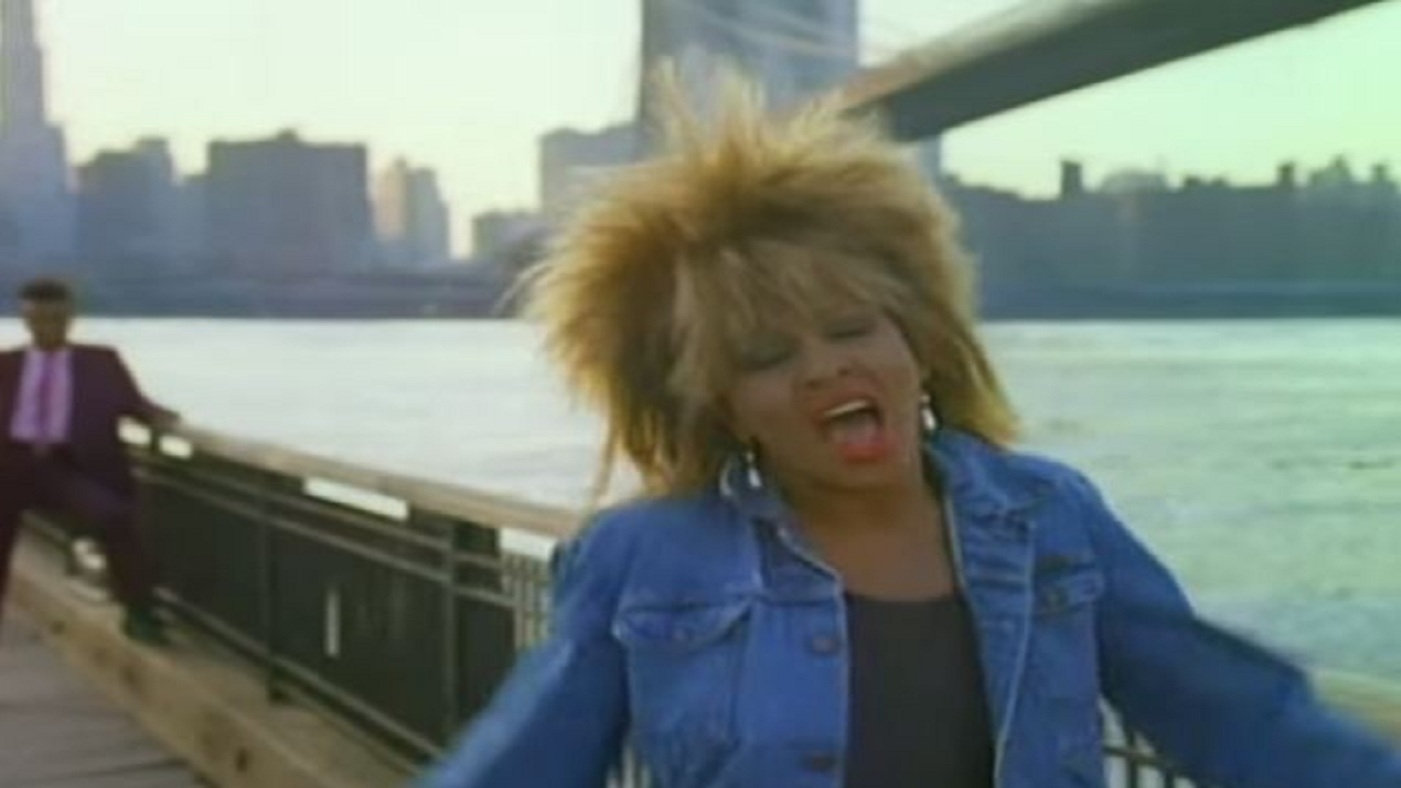This guest post written by Gwen Hofmann appears as part of our theme week on Ladies of the 1980s.
Like any self-respecting child of the eighties, I watched the recent CNN series about the decade. In the episode aptly titled “Video Killed the Radio Star,” former MTV VJ Downtown Julie Brown put the decade into perspective by likening it to looking through a kaleidoscope. Similarly, musician Questlove articulated his take on the decade’s music as being more influential than the 1960s because it incorporated additional voices. Assessments such as these are a great starting point for a discussion of the significance of musical ladies of the 1980s.
Any discussion of ladies of the 80s is incomplete without the inclusion of women in music. Bitch Flicks is devoted primarily to visual media and focuses on viewing films and television through a feminist lens. However, on August 1, 1981 MTV brought music into the format of visual media when it aired its first music video. While most people recall the first video on MTV, few remember that the second video was one of the pioneering leading ladies of the eighties: Pat Benatar with “You Better Run.” With this inauguration, women in music broadened visual representations of gender as their cacophony of voices inoculated the population to women of all ages, races, and socioeconomic backgrounds. Most intriguing about this “kaleidoscopic” decade is the way women in 80s music videos displayed these distinct portraits of womanhood. (Of course, this is not to say that there are not troublesome representations of women in 1980s music videos. This was in fact the decade of decadence which included things like the unforgettable Tawny Kitaen cartwheeling over cars, “Hot For Teacher,” and “Girls, Girls, Girls.”)
The ladies of 80s music videos brought forth new visual representations of women including: experiences in the workforce, issues of class, messages of power, and unique expressions of love and sex. In the infancy of MTV video, female artists created a complex pattern of images that underscored lyrics of power and individuality. Women were able to be quirky, androgynous, and assertive in defining their image. Strong women artists are nothing new; the decades are speckled with them especially over the 1960s and 70s. Building on the legacy of women such as Janis Joplin, Loretta Lynn, and Aretha Franklin, the new 80s format forced female artists to supplement lyrics with images.
Women visually asserted power in music videos. Some key examples of this phenomenon are observable in the videos of Joan Jett, Cyndi Lauper, and Pat Benatar. In 1981, Joan Jett released the video for her single “Bad Reputation,” which serves as an interesting starting point since women throughout history have long been held captive by threats to their reputation. Joan Jett throws years of repressive history out the window with this song and subsequent video. Jett commands viewers’ attention as she sings: “I don’t give a damn ’bout my reputation. You’re living in the past, it’s a new generation. A girl can do what she wants to do and that’s what I’m gonna do.” She visually supplements this with images of her dressed in a black leather jacket giving the middle finger to the people who told her to dress a certain way or who wouldn’t sign her to their record label. The song is strong enough on its own, but the video adds the story of how Joan Jett was discouraged by traditional venues such as major record labels — so she created her own.
This pattern of words being supplemented with images continues with songs such as “Girls Just Wanna Have Fun” and “Love is a Battlefield.” Annie Lennox and Aretha Franklin’s 1985 hit “Sisters Are Doin’ it for Themselves” does this via a screen which functions as a third person on stage alongside these intoxicating women. Annie Lennox’s androgyny and the regal beauty of Ms. Franklin are noted as they sing: “Now this is a song to celebrate the conscious liberation of the female state! … The ‘inferior sex’ got a new exterior. We got doctors, lawyers, politicians too.” The screen aside these women adds images to their words by displaying the ways women used to be portrayed followed by images of women in power. On a smaller scale Cyndi Lauper’s “Girls Just Wanna Have Fun” tells us,“Some boys take a beautiful girl and hide her away from the rest of the world. I want to be the one to walk in the sun,” as Lon Chaney steals a woman and runs off with her with the 1923 Hunchback of Notre Dame playing in the background. Also in this video, Cyndi Lauper thwarts representations of patriarchal authority, something that Pat Benatar did in her video “Love is a Battlefield” from the same year.
Cyndi Lauper and Pat Benatar rebel against the symbols of male repression. Both videos feature the father, who not only stands for authority but also is symbolic of the most rudimentary forms of patriarchal repression. As Captain Lou Albano wags his finger in her face, Cyndi turns it around and places her father in a submissive position as she giggles and walks off. Pat Benatar continues this by running away from her repressive father and navigating the male dominated streets of the urban jungle. Her video brings light to the seedy sex clubs indicative of early 80’s Times Square, NYC. Women are fondled and ogled as blank expressions crossed their faces, only ended by mobilizing the women and rebelling against the male “boss” and other oppressors. Without the visual storytelling of the video, these songs would tell a very different tale.
Women in 1980s videos offered a motley crew of visual representations. Annie Lennox and Tracy Chapman’s androgyny, Cyndi Lauper and Jane Child’s uniqueness, and Tina Turner and Jodi Watley’s sensuality brightened the rainbow of women. Most of these women broadened definitions of beauty by showing that women didn’t “have to take our clothes off to have a good time.” On a more three-dimensional level, these videos added the faces of working women. Between the 1970s and 1980s the percentage of women entering the workforce surged and women such as Dolly Parton, Donna Summer, and Chrissie Hynde gave visual representation to the working woman and the struggles of getting by amid a massive recession.
If Dolly Parton’s 1980 song “9 to 5” seems the most obvious pick for discussing working women, I believe Donna Summer best represents the double burden of women’s work in “She Works Hard for the Money.” While the title says a lot, the efficacy is erased without the video. The lyrics address a hard working woman who makes an honest living but the video takes it a step further. In doing so, the idea is driven home that this woman must work multiple jobs to make ends meet and her double shift continues when she gets home. This suggests several things, such as women possibly having to work multiple jobs to make the same money as a man as well as the idea that women’s work is twofold and does not end inside her home. Conversely, the simplicity of Tracy Chapman’s video for “Fast Car” serves to reinforce the lyrics of her intoxicating, compelling words. Sitting against a black and blue background wearing a black turtleneck, the viewer is systematically directed to the movement generated by the words falling out of her mouth and to the emotion on her face. Her quiet strength speaks volumes about the story of a woman taking on the challenges of her socioeconomic status.
Finally, key women musicians of the 80s defined their characterizations of love, relationships, and sexuality. Tina Turner was nearly 45 years old when she dominated in the 1984 song “What’s Love Got to do With It.” Her stunning beauty and sensuality commanded the streets of her video as she compelled the actions of the men and women around her. It appeared as if the men wanted to be with her and the women wanted to be her. Through this video, Tina challenged ageist ideas about women’s sensuality while touting that emotions are secondary to physicality. On a spectrum ranging from Janet Jackson’s 1986 ballad “Let’s Wait Awhile” to Samantha Fox’s racier song “Touch Me,” women dictated the terms of their relationships. Ms. Jackson emphasized the rituals of courtship and togetherness in her video while Samantha Fox stressed more primitive drives. Within these videos, the women portray images of what is important to them in their relationships. Minus the Janet Jackson video which depicts a woman dictating a slower pace, the others support a positive portrayal of pro-sex feminist ideas. While these women offered a variety of images representing love and sexuality, Suzanne Vega does even more important work by putting a face on the more nefarious side of relationships.
In the video for her song, “Luka,” Suzanne Vega is shot in simple fashion as a diminutive character who shrinks as she tells her story of domestic violence. Vega wrote the song from the perspective of a child being abused. The truth of hiding child abuse and domestic violence is represented by the video being shot in black and white, allowing Luka to blend in to the background hoping to go unnoticed so that no one asks questions. The secrets, shame, and guilt that lead people to hide their torment are assumed in the way Luka tries to be a part of the scenery. The work of “Luka” is important so that people can have a face to relate to while bringing light to a vital women’s issue (women are often the survivors of domestic violence) not easily solved. Discussion is the first defense against isolation, for with it comes visibility and belonging.

I never loved the categorization of waves of feminism because of their reductive implications, but many people tend to understand the history of women this way. That being said, the ladies of the 80s in music videos represented the ideas best understood in the second wave of feminism such as sexuality, family, and the workplace. They dressed how they wanted, rebelled against authority, laid down the rules, and they were loved by many of us for showing a broader representation of what it means to be a woman in the 80s. They used their own images and the stories of the women in their videos to show that much had been accomplished but there was still work to be done. While we can give the finger to “the man” we still gotta work hard(er) for the money.
Gwen Hofmann is currently a PhD student in the History Department at Lehigh University. She is working on her dissertation involving representations of the cruel child in popular culture. She is the co-creator of the website www.HorrorHomeroom.com and is a devoted fangirl of all things 80s.









